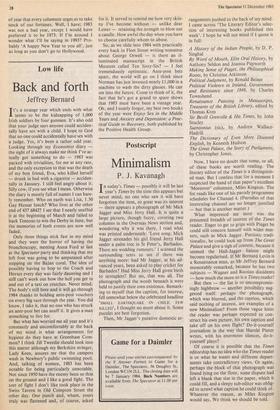Postscript
Minimalism
P. J. Kavanagh
In today's Times — possibly it will be last year's Times by the time this appears but never mind, no one who saw it will have forgotten the item, so great was its interest — there appears a photograph of Mr Mick Jagger and Miss Jerry Hall. It is quite a large picture, though fuzzy, covering two columns in the Overseas News section and, wondering why it was there, I read what was printed underneath: 'Love song: Mick Jagger serenades his girl friend Jerry Hall under a palm tree in St Peter's, Barbados. There are wedding rumours.' I scanned the surrounding texts to see if there was anything more: had Mr Jagger, at his ad- vanced years, been asked to play cricket for Barbados? Had Miss Jerry Hall given birth to sextuplets? But no, that was all. The photograph and the words beneath it were held to justify their own existence. Remark- ing to myself that the caption, for interest, fell somewhat below the celebrated headline `SMALL EARTHQUAKE IN CHILE. FEW KILLED', I thought no more about it. Some puzzles are best forgotten.
Then, Mr Jagger's putative domestic ar- rangements pushed to the back of my mind. I came across 'The Literary Editor's selec- tion of interesting books published this week'. I hope he will not mind if I quote it in full:
A History of the Indian People, by D. P. Singhal By Word of Mouth, Elite Oral History, by Anthony Seldon and Joanna Papworth Making Sense of Piaget, the Philosophical Roots, by Christine Atkinson Political Judgment, by Ronald Beiner Political Violence in Ireland, Government and Resistance since 1848, by Charles Townshend Renaissance Painting in Manuscripts, Treasures of the British Library, edited by Thomas Kren Sir Bevill Grenville & His Times, by John Stucley Suentonius (sic), by Andrew Wallace- Hadrill The Dictionary of Even More Diseased English, by Kenneth Hudson The Great Palace, the Story of Parliament, by Christopher Jones.
Now, I have no doubt that some, or all, of these books are worth reading. The literary editor of the Times is a distinguish- ed man. But I confess that for a moment 1 suspected the hand of that paper's excellent `Moreover' columnist, Miles Kington. The list reads like one of his parody programme schedules for Channel 4. (Parodies of that interesting channel are no longer justified — but that is another matter.)
What impressed me most was the presumed breadth of interest of the Times reader. Eager to get to grips with Piaget he could still concern himself with wider mat- ters, such as Mick Jagger. Patriotic tradi- tionalist, he could look up from The Great Palace and give a sigh of content, because it seemed the Hall-Jagger liaison might become regularised. If Mr Bernard Levin is a Renaissance man, as Mr Jeffrey Bernard memorably remarked, because he has two subjects — Wagner and Russian dissidents — how much the more so is a Times reader!
But then — the list is so uncompromis- ingly highbrow — another possibility sug- gested itself: perhaps the photograph, which was blurred, and the caption, which said nothing of interest, are examples of a new Minimalism? From those vague hints the reader was perhaps expected to con- struct his own picture, his own caption and take off on his own flight? Do-it-yourself journalism in the way that Harold Pinter writes, with his enormous silences, do-it- yourself plays?
Of course it is possible that the Times editorship has no idea who the Times reader is or what he wants and different depart- ments take contradictory views. Or again, perhaps the block of that photograph was found lying on the floor, some dispute had
left a blank that size in the paper, which it could fill, and a sleepy sub-editor was oblig- ed to scrawl what caption he could think of. Whatever the reason, as Miles Kington would say, We think we should be told.














































 Previous page
Previous page